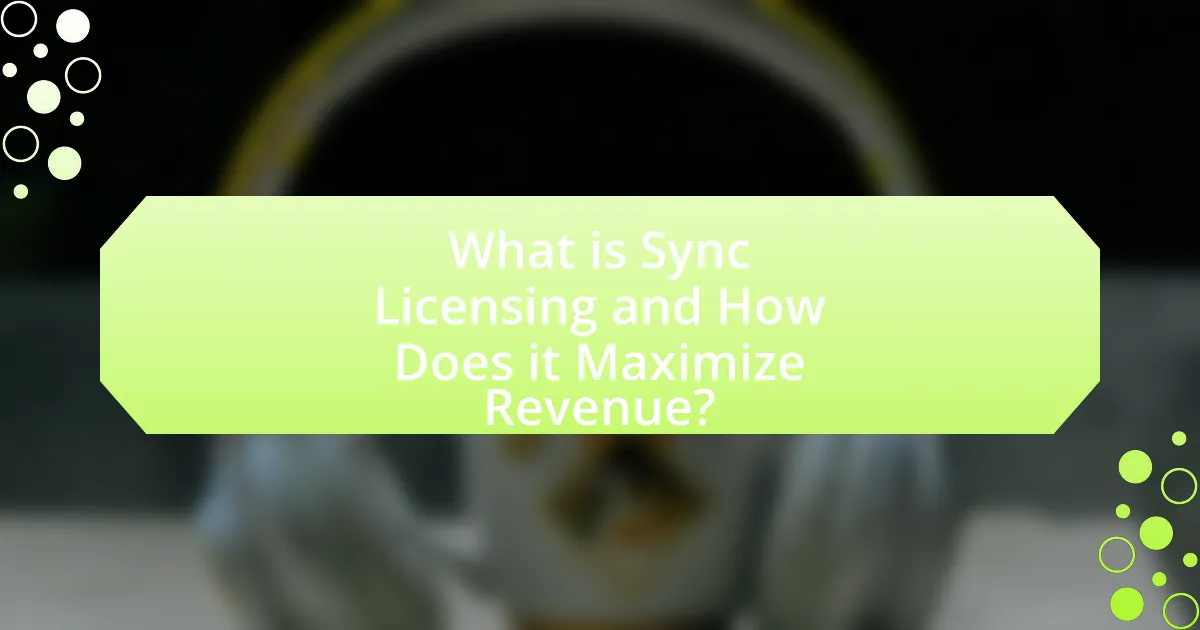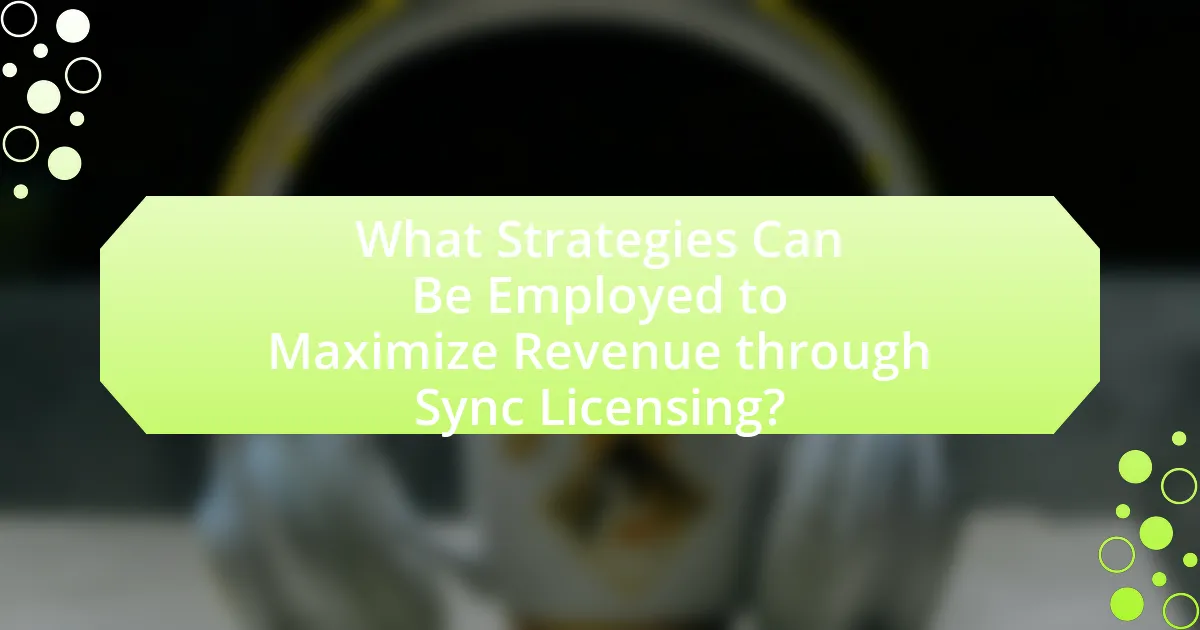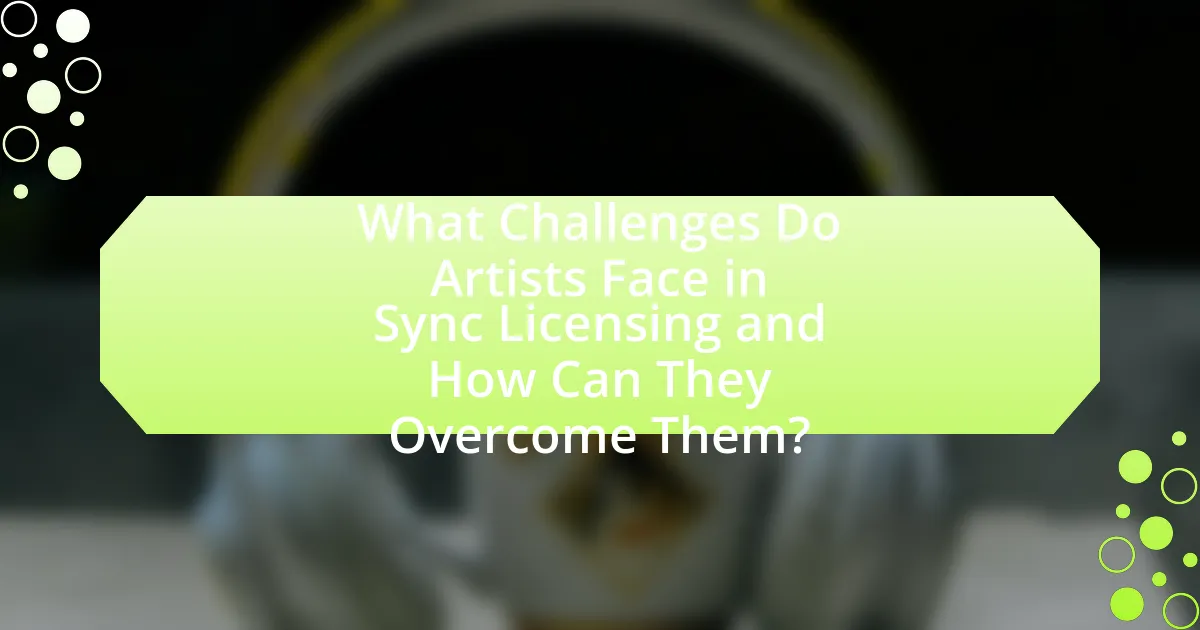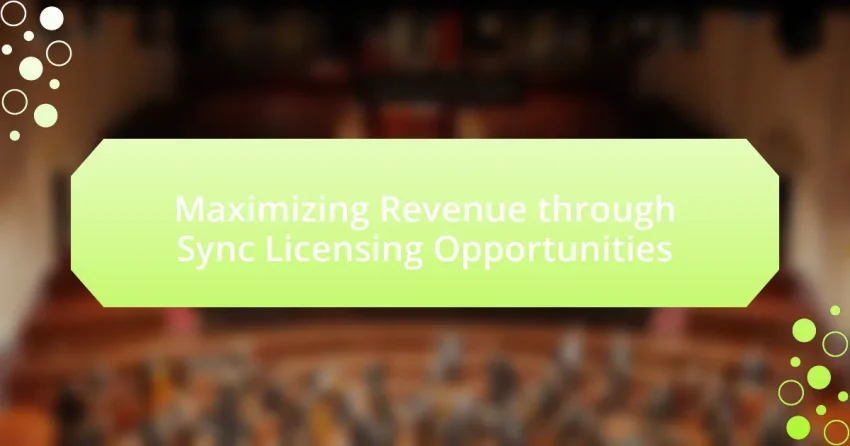Sync licensing is the process of obtaining permission to use music in visual media, such as films, television shows, and advertisements, which can significantly enhance revenue for music creators. This article explores how sync licensing works, the key components of licensing agreements, and the benefits for rights holders, including financial compensation and increased exposure. It also discusses the types of media that utilize sync licensing, strategies for maximizing revenue, and the challenges artists face in securing deals. Additionally, the article highlights best practices for negotiating agreements and the role of technology and networking in enhancing sync licensing opportunities.

What is Sync Licensing and How Does it Maximize Revenue?
Sync licensing is the process of obtaining permission to use a piece of music in conjunction with visual media, such as films, television shows, advertisements, or video games. This licensing maximizes revenue by allowing music creators to earn fees for the use of their work, which can be substantial; for example, a single sync placement in a popular TV show can generate thousands to tens of thousands of dollars. Additionally, sync licensing can enhance the visibility and popularity of the music, leading to increased sales, streaming, and performance opportunities, thereby creating multiple revenue streams for artists and rights holders.
How does sync licensing work in the music industry?
Sync licensing in the music industry involves the legal permission to use a piece of music in conjunction with visual media, such as films, television shows, commercials, or video games. This process typically requires the rights holder, often the songwriter or publisher, to grant a license to the producer or director of the visual project, allowing them to synchronize the music with their content. The licensing agreement usually includes terms regarding payment, duration of use, and specific rights granted, which can vary widely based on the project’s scope and the music’s popularity. According to the American Association of Independent Music, sync licensing has become a significant revenue stream for artists, with the global sync licensing market projected to reach $1.5 billion by 2025, highlighting its importance in maximizing revenue opportunities for musicians.
What are the key components of a sync licensing agreement?
The key components of a sync licensing agreement include the scope of the license, the duration of the license, the territory in which the license is valid, the fees or royalties to be paid, and the rights granted to the licensee. The scope defines how the music can be used, such as in film, television, or advertisements. The duration specifies how long the license is effective, while the territory outlines the geographical areas where the music can be used. Fees or royalties detail the financial compensation for the use of the music, and the rights granted clarify what the licensee can do with the music, including any restrictions. These components are essential for establishing clear terms and protecting the interests of both parties involved in the agreement.
How do rights holders benefit from sync licensing?
Rights holders benefit from sync licensing primarily through financial compensation and increased exposure for their works. When their music is licensed for use in films, commercials, or video games, rights holders receive upfront fees and potential royalties, which can significantly enhance their revenue streams. For instance, a study by the Music Business Association indicates that sync licensing can generate up to 50% of a songwriter’s income, showcasing its importance in maximizing revenue. Additionally, sync placements can lead to heightened visibility and popularity of the music, resulting in increased sales and streaming activity, further benefiting rights holders.
What types of media utilize sync licensing?
Sync licensing is utilized by various types of media, including television shows, films, advertisements, video games, and online content such as YouTube videos and podcasts. Each of these media formats incorporates music to enhance storytelling, evoke emotions, or create brand identity. For instance, television shows and films often use sync licensing to integrate popular songs that resonate with audiences, while advertisements rely on catchy tunes to capture attention and promote products effectively. Video games also employ licensed music to create immersive experiences, and online content creators use sync licensing to monetize their videos and podcasts legally.
How do films and television shows leverage sync licensing?
Films and television shows leverage sync licensing by obtaining the rights to use music in their productions, which enhances storytelling and emotional engagement while generating revenue. This practice allows creators to incorporate popular songs or original compositions that resonate with audiences, thereby increasing the production’s appeal and marketability. For instance, a study by the Music Business Association indicates that sync licensing can significantly boost a film’s or show’s visibility and sales, as music often plays a crucial role in marketing campaigns and promotional materials. Additionally, successful sync placements can lead to increased streaming and sales of the licensed tracks, benefiting both the production and the artists involved.
What role does advertising play in sync licensing opportunities?
Advertising plays a crucial role in sync licensing opportunities by creating demand for specific songs in various media formats. Advertisers often seek music that resonates with their target audience, leading to increased visibility and potential revenue for artists and rights holders. For instance, a study by the American Association of Advertising Agencies found that 70% of consumers recall ads with music, indicating that effective sync placements can enhance brand recognition and drive sales. This symbiotic relationship between advertising and music licensing not only boosts the artist’s exposure but also opens up additional revenue streams through licensing fees and royalties.
Why is sync licensing important for artists and composers?
Sync licensing is important for artists and composers because it provides a significant revenue stream through the placement of their music in visual media such as films, television shows, and advertisements. This form of licensing allows creators to earn money not only from the initial licensing fee but also from performance royalties generated when the media is broadcasted. According to the American Society of Composers, Authors and Publishers (ASCAP), sync licensing has become increasingly lucrative, with the market for music in media projected to grow, highlighting its vital role in maximizing revenue for artists and composers.
How can sync licensing create new revenue streams for musicians?
Sync licensing can create new revenue streams for musicians by allowing their music to be used in various media such as films, television shows, commercials, and video games. This practice generates income through licensing fees, which can be substantial; for example, a single sync license can earn a musician anywhere from a few hundred to several thousand dollars, depending on the project’s scale and budget. Additionally, successful placements can lead to increased exposure and sales of the musician’s music, further enhancing their revenue potential. According to a report by the Music Business Association, sync licensing has become a significant source of income for artists, with the market for music licensing projected to grow significantly in the coming years.
What impact does sync licensing have on an artist’s exposure?
Sync licensing significantly enhances an artist’s exposure by placing their music in visual media such as films, commercials, and television shows. This strategic placement allows artists to reach broader audiences who may not be familiar with their work, thereby increasing their visibility and potential fan base. For instance, a study by the Music Business Association found that songs featured in popular TV shows can lead to a 200% increase in streaming activity for the artist. Additionally, sync licensing can create lasting associations between the music and the visual content, further embedding the artist’s work in popular culture and driving future sales and streams.

What Strategies Can Be Employed to Maximize Revenue through Sync Licensing?
To maximize revenue through sync licensing, creators should focus on building a diverse catalog of high-quality music that appeals to various media types, including film, television, and advertising. A diverse catalog increases the chances of placements, as different projects require different styles and genres. Additionally, establishing strong relationships with music supervisors and industry professionals can lead to more opportunities for licensing, as these connections often result in recommendations and direct placements.
Furthermore, leveraging digital platforms for visibility, such as music libraries and sync licensing agencies, can enhance exposure to potential clients. According to a report by the Music Business Association, sync licensing revenue has grown significantly, indicating a lucrative market for well-positioned music. By actively promoting their work and staying informed about industry trends, creators can better align their offerings with market demands, ultimately maximizing their revenue potential in sync licensing.
How can artists effectively pitch their music for sync opportunities?
Artists can effectively pitch their music for sync opportunities by creating a targeted pitch that highlights the unique aspects of their music and aligns it with the specific needs of the project. This involves researching the production company or music supervisor, understanding the type of music they typically use, and tailoring the submission to fit those criteria.
For instance, including a brief description of the song’s mood, instrumentation, and potential use cases can enhance the pitch. Additionally, providing high-quality audio files, along with metadata that includes contact information and licensing terms, ensures that the music is easily accessible and professionally presented.
Statistics show that personalized pitches have a higher success rate; a study by the Music Business Association found that 70% of music supervisors prefer pitches that are tailored to their specific projects. This demonstrates the importance of customization in increasing the likelihood of securing sync placements.
What elements should be included in a successful pitch?
A successful pitch should include a clear value proposition, a compelling narrative, and relevant data to support claims. The value proposition articulates the unique benefits of the offering, making it clear why it stands out in the market. A compelling narrative engages the audience emotionally, helping them connect with the content. Relevant data, such as market trends or case studies, provides evidence that reinforces the pitch’s credibility and demonstrates potential success. For instance, a study by the Music Business Association indicates that sync licensing can increase revenue by up to 30% for artists, showcasing the financial benefits of effective pitches in this context.
How can networking enhance sync licensing prospects?
Networking can significantly enhance sync licensing prospects by creating valuable connections with industry professionals who can facilitate opportunities. Engaging with music supervisors, producers, and other artists through networking events or online platforms increases visibility and access to potential projects requiring music. For instance, a study by the Music Business Association indicates that 70% of sync placements occur through personal relationships, underscoring the importance of networking in this field. By building a robust network, artists can gain insights into industry trends, receive referrals, and ultimately increase their chances of securing sync licensing deals.
What are the best practices for negotiating sync licensing deals?
The best practices for negotiating sync licensing deals include understanding the value of the music, establishing clear terms, and maintaining open communication. Knowing the market rates for similar licenses helps in setting a fair price, while clearly defining the scope of use, duration, and territory ensures both parties have aligned expectations. Open communication fosters a collaborative environment, allowing for adjustments and clarifications as needed. According to a 2021 report by the Music Business Association, effective negotiation strategies can increase licensing revenue by up to 30%, highlighting the importance of these practices in maximizing revenue through sync licensing opportunities.
How can understanding market rates improve negotiation outcomes?
Understanding market rates enhances negotiation outcomes by providing a benchmark for fair pricing and value assessment. When negotiators are aware of prevailing market rates, they can make informed decisions, ensuring that their offers or counteroffers are competitive and justified. This knowledge allows them to articulate their position effectively, reducing the likelihood of overpricing or underpricing their services. For instance, a study by the International Association of Business Communicators found that organizations that utilized market data in negotiations achieved a 20% higher success rate in closing deals compared to those that did not. Thus, understanding market rates not only empowers negotiators with confidence but also increases the probability of favorable agreements.
What common pitfalls should be avoided during negotiations?
Common pitfalls to avoid during negotiations include failing to prepare adequately, which can lead to a lack of clarity on objectives and limits. Research indicates that 70% of negotiators who do not prepare thoroughly end up with less favorable outcomes. Additionally, allowing emotions to dictate decisions can result in irrational choices, as studies show that emotional decision-making often leads to suboptimal agreements. Another significant pitfall is not actively listening to the other party, which can cause misunderstandings and missed opportunities for collaboration. Effective negotiators prioritize understanding the other party’s needs, as this can facilitate more productive discussions and better outcomes.
How can technology aid in maximizing sync licensing revenue?
Technology can aid in maximizing sync licensing revenue by streamlining the licensing process and enhancing data analytics capabilities. Digital platforms enable faster negotiations and transactions, reducing the time between music selection and licensing agreements. For instance, automated licensing platforms can facilitate real-time access to music catalogs, allowing content creators to find and license tracks more efficiently. Additionally, advanced analytics tools can track usage data and audience engagement, providing insights that help rights holders optimize their licensing strategies. According to a report by the International Confederation of Societies of Authors and Composers, the use of technology in music licensing has led to a 30% increase in revenue for rights holders by improving transparency and efficiency in the licensing process.
What platforms are available for artists to showcase their music for sync licensing?
Artists can showcase their music for sync licensing on platforms such as Musicbed, Artlist, Epidemic Sound, and AudioJungle. These platforms provide a marketplace where artists can upload their tracks, making them accessible to filmmakers, advertisers, and other content creators seeking music for their projects. Musicbed, for instance, is known for its curated selection of high-quality music, while Epidemic Sound offers a subscription model that allows users to access a vast library of tracks. Artlist focuses on providing unlimited downloads for a flat fee, appealing to independent creators. AudioJungle, part of the Envato Market, allows artists to sell individual tracks, catering to a wide range of users. Each of these platforms has established a reputation in the industry, facilitating connections between artists and potential licensing opportunities.
How can data analytics inform sync licensing strategies?
Data analytics can inform sync licensing strategies by providing insights into consumer preferences and trends, enabling targeted marketing and selection of music for specific media. By analyzing streaming data, social media interactions, and demographic information, companies can identify which songs resonate with audiences and are more likely to succeed in sync placements. For instance, a study by Nielsen Music found that tracks with higher streaming numbers are often more sought after for sync opportunities, as they indicate popularity and listener engagement. This data-driven approach allows for more strategic decisions in licensing, ultimately maximizing revenue through better alignment of music with content that appeals to target audiences.

What Challenges Do Artists Face in Sync Licensing and How Can They Overcome Them?
Artists face several challenges in sync licensing, including lack of industry knowledge, difficulty in negotiating fair terms, and competition from established artists. To overcome these challenges, artists can educate themselves about the sync licensing process through workshops and online resources, seek legal advice to ensure fair contract terms, and build relationships with music supervisors and industry professionals to increase their visibility. According to a 2021 report by the Music Business Association, artists who actively network and understand the licensing landscape are more likely to secure lucrative sync deals.
What are the common obstacles in securing sync licensing deals?
Common obstacles in securing sync licensing deals include unclear rights ownership, lack of industry connections, and insufficient understanding of licensing terms. Unclear rights ownership can lead to disputes over who has the authority to license a track, which complicates negotiations. Lack of industry connections often results in missed opportunities, as many deals are facilitated through established relationships. Insufficient understanding of licensing terms can hinder artists and rights holders from effectively negotiating favorable agreements, potentially leading to unfavorable terms or missed revenue.
How can artists navigate the complexities of copyright laws?
Artists can navigate the complexities of copyright laws by understanding their rights and utilizing legal resources effectively. Familiarizing themselves with the Copyright Act of 1976, which grants creators exclusive rights to their original works, is essential for artists to protect their intellectual property. Additionally, artists should consider consulting with copyright attorneys or organizations like the American Society of Composers, Authors and Publishers (ASCAP) or the Broadcast Music, Inc. (BMI) for guidance on licensing agreements and copyright registration. Engaging in workshops or online courses focused on copyright law can also enhance their knowledge and help them make informed decisions regarding sync licensing opportunities, ultimately maximizing their revenue.
What strategies can be employed to stand out in a competitive market?
To stand out in a competitive market, businesses should focus on differentiation through unique value propositions, targeted marketing, and exceptional customer service. Differentiation allows a company to highlight what makes its offerings distinct, such as innovative features or superior quality, which can attract customers seeking specific benefits. Targeted marketing ensures that promotional efforts reach the right audience, increasing engagement and conversion rates. Exceptional customer service fosters loyalty and encourages word-of-mouth referrals, which are crucial in crowded markets. According to a 2021 study by HubSpot, 93% of customers are likely to make repeat purchases with companies that offer excellent customer service, underscoring its importance in maintaining a competitive edge.
How can artists protect their rights in sync licensing agreements?
Artists can protect their rights in sync licensing agreements by ensuring that all terms are clearly defined and legally documented. This includes specifying the scope of use, duration, and compensation in the agreement. Additionally, artists should retain ownership of their master recordings and publishing rights whenever possible, as this allows them to control how their music is used and to receive appropriate royalties. Legal counsel specializing in music rights can provide guidance on negotiating favorable terms and understanding the implications of the agreement. According to the Music Industry Association, artists who actively engage in the licensing process and seek professional advice are more likely to secure their rights and maximize their revenue from sync opportunities.
What legal considerations should be taken into account?
Legal considerations in sync licensing include copyright ownership, licensing agreements, and compliance with performance rights organizations. Copyright ownership determines who has the legal right to license the music, which is crucial for ensuring that the correct parties are compensated. Licensing agreements must clearly outline the terms of use, duration, and payment structures to avoid disputes. Compliance with performance rights organizations, such as ASCAP or BMI, is essential to ensure that royalties are properly collected and distributed. These factors are critical for maximizing revenue and minimizing legal risks in sync licensing opportunities.
How can artists ensure fair compensation for their work?
Artists can ensure fair compensation for their work by negotiating clear contracts that specify payment terms and rights related to sync licensing. By establishing detailed agreements, artists can protect their intellectual property and ensure they receive appropriate royalties for the use of their music in various media. According to the American Society of Composers, Authors and Publishers (ASCAP), artists who actively engage in licensing negotiations can increase their earnings significantly, as sync licensing has become a major revenue stream, generating over $1 billion annually for songwriters and composers.
What practical tips can help maximize revenue through sync licensing?
To maximize revenue through sync licensing, creators should focus on building a diverse catalog of high-quality music that appeals to various media types. A diverse catalog increases the chances of placement in films, commercials, and television shows, which can lead to higher licensing fees. Additionally, networking with music supervisors and industry professionals is crucial, as personal relationships can lead to more opportunities for sync placements.
Furthermore, understanding the specific needs of different media outlets allows creators to tailor their music accordingly, enhancing the likelihood of being selected for projects. For instance, knowing that upbeat tracks are often sought for commercials can guide creators in producing suitable content.
Finally, leveraging digital platforms for visibility and promotion can attract more attention from potential licensees. Statistics show that music with a strong online presence is more likely to be discovered by industry professionals, thereby increasing sync licensing opportunities.
How can maintaining a diverse catalog enhance sync licensing opportunities?
Maintaining a diverse catalog enhances sync licensing opportunities by providing a wider range of musical styles and genres that can appeal to various media projects. A diverse catalog increases the likelihood of matching specific project needs, as different films, commercials, and television shows often seek unique sounds to complement their narratives. For instance, a study by the Music Business Association indicates that projects with varied musical selections are more likely to secure licensing deals, as they can cater to different audience demographics and creative visions. This adaptability not only attracts more clients but also maximizes revenue potential through increased licensing agreements.
What role does continuous learning play in successful sync licensing?
Continuous learning is essential for successful sync licensing as it enables music creators and industry professionals to stay updated on trends, technologies, and legal frameworks. This ongoing education helps them understand the evolving landscape of media consumption and licensing requirements, which directly impacts their ability to secure lucrative sync deals. For instance, knowledge of current licensing practices and market demands can lead to better negotiation strategies and more tailored music offerings, ultimately increasing revenue potential.
